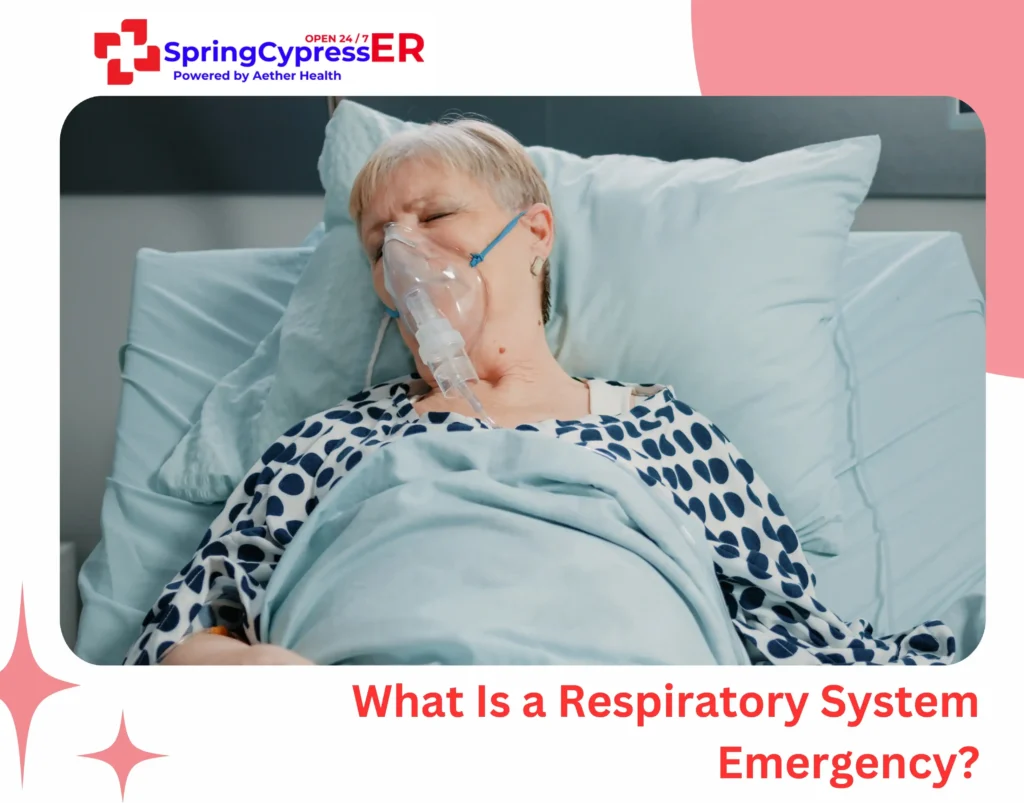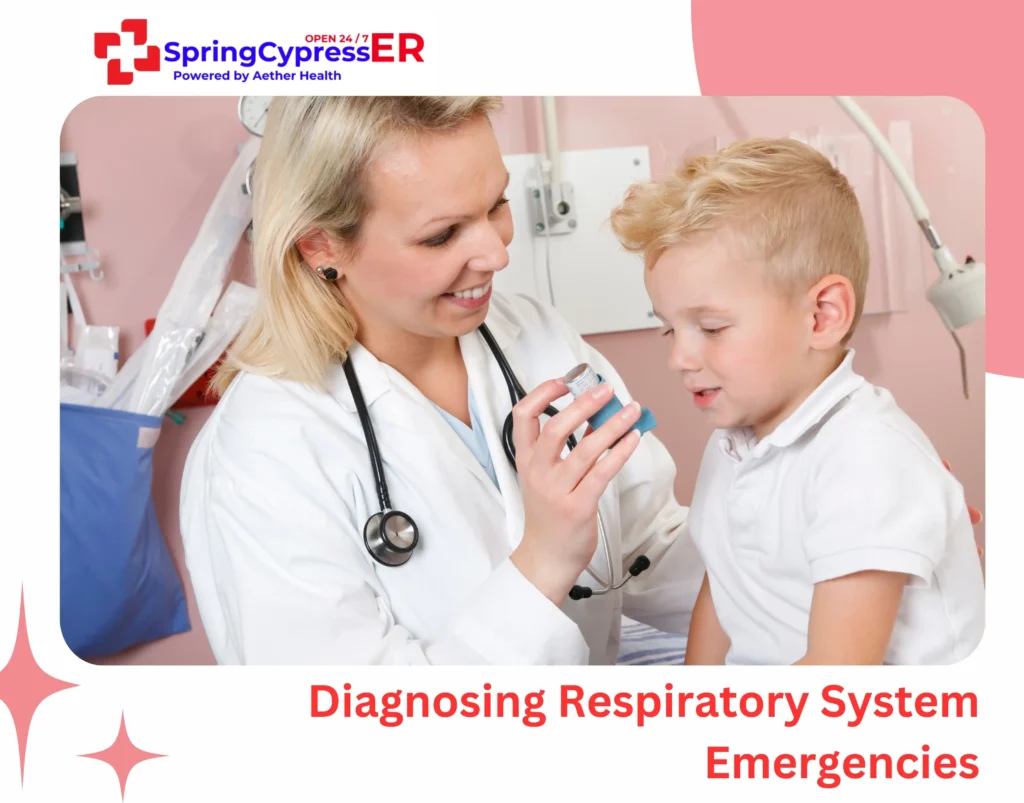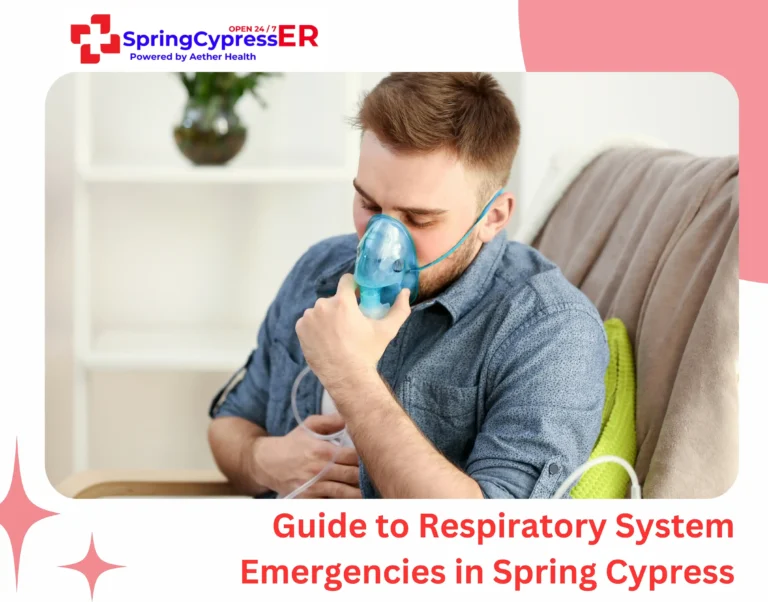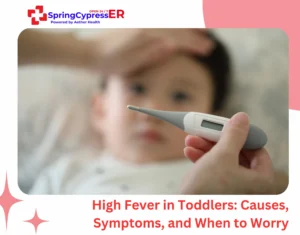Respiratory illness can quickly escalate from concerning to critical. Whether it’s sudden chest tightness, severe wheezing, or struggling for breath, knowing when to seek emergency care is crucial for your safety.
At Spring Cypress ER, we specialize in treating respiratory system emergencies with advanced diagnostics and specialized care. From asthma attacks to severe respiratory infections, our emergency team is equipped to stabilize your condition and prevent life-threatening complications.
What Is a Respiratory System Emergency?

Respiratory system emergency is a health condition that severely impedes breathing or the body’s capability to effectively exchange oxygen. These urgent conditions can arise from infections, long-term illnesses, or sudden injuries, presenting major health hazards. Without prompt and suitable action, respiratory issues can develop into serious complications or even lead to death.
Symptoms of a Respiratory Emergency
Watch for these critical symptoms that signal a respiratory system emergency:
- Difficulty Breathing: Gasping for air or feeling like you can’t get enough oxygen
- Wheezing or Whistling Noises: Signs of blocked airways needing immediate attention
- Irregular Breathing Pattern: Breathing that’s unusually fast or uneven
- Chest Discomfort: Sudden pain or a feeling of tightness in your chest
- Cyanosis: The bluish color of lips or fingers, indicating oxygen deficiency
- Fatigue and Confusion: Feeling unusually tired or confused
Common Respiratory Emergencies We Treat in Spring ER
1. Asthma Attacks
Asthma is a chronic respiratory condition characterized by inflamed airways. During an asthma attack, these airways become severely narrowed, making breathing difficult. Triggers may include allergens, respiratory infections, or environmental irritants.
Interventions for respiratory emergency due to asthma include:
- Administering quick-relief bronchodilators (inhalers)
- Using systemic corticosteroids to reduce inflammation
- Providing oxygen therapy in severe case
2. Upper Respiratory Infections
Infections in the nasal passages, throat, or upper airways whether viral or bacterial can quickly turn serious, especially for those with weakened immune systems. Watch for telltale signs like a lingering fever, constant coughing, and heavy nasal congestion.
When it comes to treatment:
- Doctors may run quick lab tests to pinpoint the cause
- Depending on the results, you might need antivirals or antibiotics
- Don’t underestimate the power of simple remedies: staying hydrated, getting plenty of rest, and letting your body heal
Catching these infections early and taking action can make all the difference.
3. Bronchitis and Pneumonia
Bronchitis is characterized by the inflammation of the bronchial tubes, whereas pneumonia impacts the air sacs in the lungs. If left untreated, both conditions can lead to significant breathing challenges.
Respiratory emergency treatment for these conditions includes:
- Chest X-rays or CT scans to evaluate the severity of the condition
- Blood tests to identify markers of infection
- Antibiotics for bacterial infections or antiviral medications for viral pneumonia
- Oxygen therapy in more severe instances
4. COVID-19 and RSV
COVID-19, Respiratory Syncytial Virus (RSV), and other winter respiratory viruses have emerged as significant contributors to medical emergencies, particularly in vulnerable populations like children and the elderly. These conditions often present with cough, fever, and difficulty breathing.
Doctors address these emergencies through:
- Rapid testing to confirm the diagnosis
- Administering antiviral therapies
- Providing ventilatory support if necessary
Diagnosing Respiratory System Emergencies

When dealing with a respiratory system emergency, timely and accurate diagnosis is essential for effective intervention. Advanced diagnostic tools allow us to identify the underlying cause, severity, and recommend appropriate respiratory emergency treatment.
Advanced Imaging
Imaging technologies like chest X-rays, CT scans, and ultrasounds play a vital role in assessing the respiratory condition. These tools detect structural abnormalities, fluid buildup, and infections in the lungs.
For instance, a chest X-ray can reveal signs of pneumonia, while a CT scan can diagnose pulmonary embolism or advanced COPD.
Rapid Testing
Our emergency room provides rapid testing for COVID-19, RSV, influenza and other conditions to identify specific causes of distress. These diagnostic tests are critical in guiding targeted treatments, including antivirals, oxygen therapy, or isolation measures.
Blood Tests
Our advanced blood testing helps pinpoint the cause and severity of your respiratory emergency. We measure oxygen and carbon dioxide levels in your blood while checking for signs of infection or inflammation. This detailed analysis also provides crucial information about your lung function and how well you’re responding to treatment.
Common blood tests in Spring Cypress ER include:
- Arterial Blood Gas (ABG) to check oxygen levels
- Complete Blood Count (CBC) to detect infections
- C-Reactive Protein (CRP) to measure inflammation
- D-dimer for blood clot screening
- Basic Metabolic Panel to assess organ function
With quick, accurate results from our onsite lab, we can fine-tune your care plan immediately – whether you need oxygen therapy, medication adjustments, or more intensive respiratory support. This precise diagnostic approach ensures you receive exactly the care you need without any delay.
Respiratory Emergency Treatment
Interventions for respiratory emergencies demand both rapid response and precise care. Common respiratory emergency treatments include:
Medications
Medications are often the first line of defense in a respiratory emergency:
- Bronchodilators: These drugs relax the muscles around the airways, improving airflow and relieving symptoms of asthma or COPD exacerbations. They are often administered through inhalers or nebulizers for rapid effect.
- Corticosteroids: These anti-inflammatory medications help reduce airway swelling, making breathing easier. They are crucial in managing severe asthma attacks or allergic reactions.
- Antibiotics or Antivirals: Infections such as bacterial pneumonia or viral conditions like influenza are treated with targeted medications to eliminate the root cause and prevent further complications.
Oxygen Therapy
Oxygen supplementation is a fundamental part of respiratory emergency treatment, ensuring the body receives adequate oxygen. Delivery methods include:
- Nasal Cannulas or Masks: For mild to moderate cases requiring supplemental oxygen.
- Mechanical Ventilation: In critical situations, this technology takes over breathing for the patient, allowing the lungs to rest and heal.
Ventilatory Support
Severe respiratory emergencies that affect normal breathing may require advanced ventilatory support:
- Non-Invasive Ventilation (CPAP or BiPAP): These devices deliver pressurized air to keep airways open, particularly for conditions like sleep apnea or COPD flare-ups.
- Mechanical Ventilation: Reserved for life-threatening situations, this intervention supports or completely replaces natural breathing.
Lifestyle Modifications
Making smart lifestyle changes can significantly reduce your risk of respiratory emergencies.:
- Quit Smoking: The most important step is to quit smoking. Nothing impacts lung health more dramatically.
- Avoid Pollutants: Minimizing exposure to environmental toxins, allergens, or irritants can significantly reduce flare-ups.
- Hygiene Practices: Washing hands, wearing masks, and staying updated on vaccinations are vital for the prevention of respiratory emergencies, particularly infections.
Prevention of Respiratory Emergencies

Prevention is your best defense against respiratory emergencies. Here’s how you can protect your respiratory health:
Vaccinations
Keep current with flu shots, COVID-19 vaccines, and pneumonia immunizations. These are especially crucial if you’re older, have chronic conditions, or a weakened immune system.
Manage Chronic Conditions
If you have asthma, COPD, or other respiratory conditions, stick to your medication schedule and regular check-ups with your doctor. Proper management prevents minor issues from becoming emergencies.
Healthy Lifestyle Choices
A strong body supports healthy lungs. Eat a nutrient-rich, balanced diet to boost your immune system and exercise regularly to strengthen your respiratory muscles. The most important step is quitting smoking, as it directly reduces inflammation and damage to the airways. Avoiding secondhand smoke and limiting exposure to environmental toxins also plays a major role in maintaining lung health.
Monitoring Air Quality
Pay attention to air quality, both indoors and out. Use air purifiers at home and check local air quality indexes before outdoor activities. This is particularly important during high-pollution days or allergy seasons.
Know the Warning Signs
Don’t ignore early symptoms like persistent coughing, chest pain, unusual fatigue, and breathing problems in kids such as wheezing or labored breathing. Early intervention often prevents serious complications.
Navigating Respiratory System Emergencies
Respiratory emergencies don’t announce themselves politely. Symptoms like gasping for air, chest pain that sharpens with every breath, or coughing up blood demand swift medical attention.
At Spring Cypress ER, we’re equipped with the tools and experienced staff to handle respiratory emergencies 24/7. Our onsite laboratory provides testing for COVID-19, RSV, strep and mono tests, complete blood count (CBC), and other critical markers.
If you’re unsure about your worsening symptoms, it’s always better to get checked out sooner rather than later.
FAQs
What do doctors do for respiratory emergencies?
Doctors assess symptoms, perform diagnostics (imaging, blood tests), and provide treatments like medications, oxygen therapy, or ventilatory support, while monitoring recovery closely.
What are the complications of respiratory emergencies?
Complications of respiratory emergencies include respiratory failure, cardiac arrest, brain damage from oxygen deprivation, organ failure, and increased risk of infections or long-term lung damage.
What is the first aid for respiratory emergencies?
First aid for respiratory emergencies includes calling 911, keeping the airway clear, assisting with inhalers or oxygen if available, and performing CPR if breathing stops.




